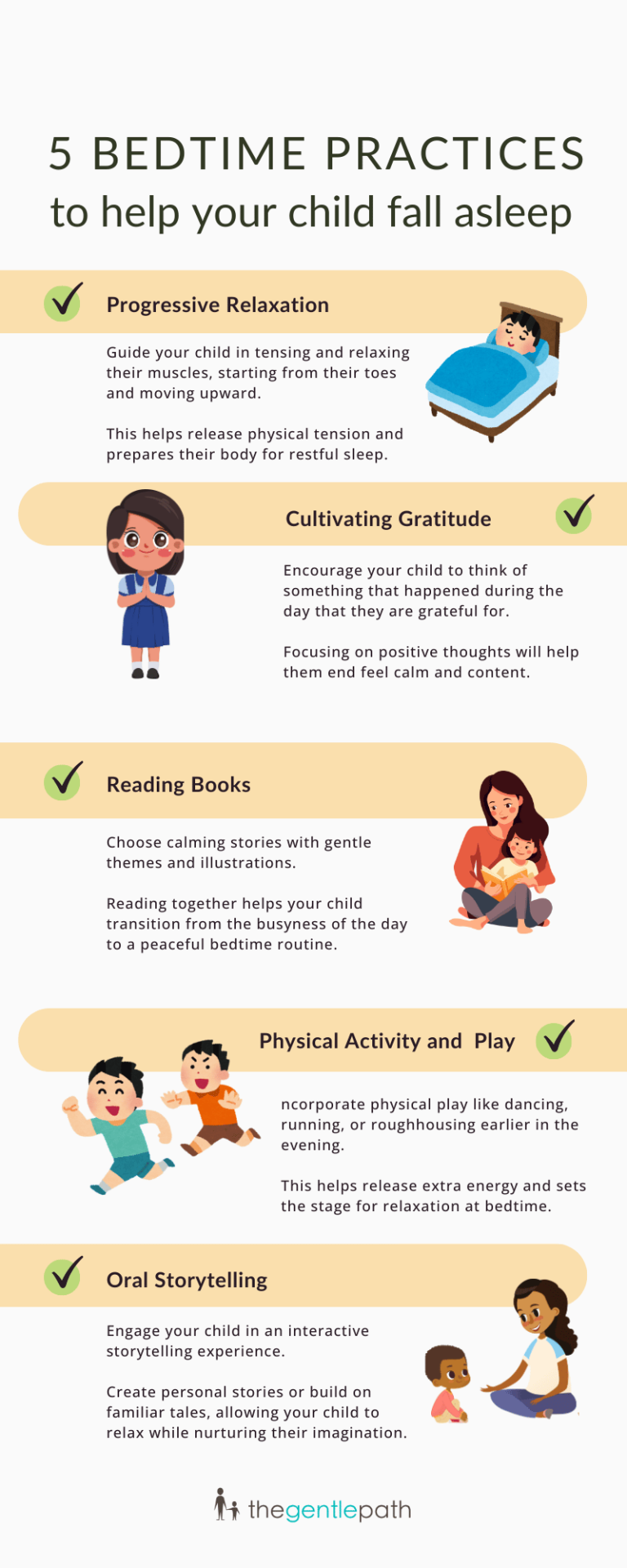Bedtime can often feel like a battleground, especially when children have boundless energy or lingering excitement from the day. But what if you could transform it into a peaceful, enjoyable experience for both you and your child?
In this article, we’ll explore five powerful practices to help children aged 5-7 relax their mind and body before bed. From gratitude and progressive relaxation to physical play and storytelling, these techniques can make bedtime a calm and positive way to end the day.
Practice #1: Progressive Muscle Relaxation.

Progressive relaxation is a powerful technique that helps your child release physical tension and prepares their body for restful sleep. It involves tensing and then relaxing different muscle groups in sequence, allowing children to become more aware of their bodies and how it feels to be completely relaxed.
With regular practice, your child will become better at releasing physical tension so they can enjoy a peaceful night’s sleep.
Guide Your Child Through the Process.
Progressive relaxation works best when your child is lying in bed. Using a soothing voice, guide them through tensing and then releasing different parts of their body—from their toes to their head. Encourage them to notice how relaxed their body feels after letting go of the tension.
To make this easier, download my Progressive Relaxation Script for 5-7 Year Olds and use it to guide your child through the process. The script is designed with language and imagery for young children, to help them visualize and enjoy the steps.
Practice #2: Cultivate Gratitude.
Gratitude helps children shift their focus from what went wrong during the day to what went right. It encourages a positive mindset, helping your child feel more settled and content, and makes it easier for them to drift off to sleep.

Create a Gratitude Ritual.
As you tuck your child in, make it a habit to ask, “What’s one thing you’re grateful for today?” Encourage them to think about the simple, joyful moments—like a fun game they played, a delicious snack they enjoyed, or a hug from someone they love.
If your child struggles to come up with something, gently prompt them with questions like, “What about when you found your stuffed bear behind the couch? Or when you made your own sandwich?”
To deepen the experience, you can both place a hand on your heart, close your eyes, and take a few moments to truly feel the gratitude, rather than just talking about it. Sharing your own gratitude for the day with your child will create sweet memories that will last a lifetime.
Practice #3: Reading Books.

Reading before bed is a cherished tradition for many families. A good book can help your child unwind, transition from the day’s activities, and feel safe and connected before sleep.
Tips for a successful reading ritual.
- Pick stories with gentle narratives and soothing illustrations to create a relaxing atmosphere. Avoid books that may overstimulate your child.
- Allow your child to choose the book, so they are involved and excited about reading.
- Designate a comfortable reading area, with soft lighting and a cozy setup.
- Reading regularly at bedtime helps signal to your child that it’s time to wind down and relax for the night.
Practice #4: Physical Activity and Play.
Children often have an abundance of energy that may interfere with their ability to fall asleep. Playful, physical activities are a great way to help them burn off that extra energy and process any excitement from the day.
If physical activity tends to energize your child, it’s best to include it earlier in the evening, allowing them time to wind down and relax before bedtime.

Some Activities You Can Try.
- Dancing: Turn on some music and have a dance party. Let your child move freely, express themselves, and get their heart rate up.
- Roughhousing: Safe, playful wrestling or tumbling with a parent can help release energy and develop self-regulation. Keep it fun and light with clear limits.
- Outdoor Play: Encourage your child to run around outside, and enjoy the fresh air and the sunlight. This helps regulate their internal clock, making it easier to fall asleep later on.
Practice #5: Oral Storytelling.

Oral storytelling is a magical way to help your child wind down at the end of the day. It sparks their imagination while releasing any lingering tension or worries from the day.
While many parents choose to read stories from books, telling a story can create a deeper connection with your child. Since you’re not tied to the words on the page, you can tailor the story to your child’s life and experiences, making it more personal and relatable.
Storytelling helps your child address their concerns or fears in a way that feels safe and gentle. Many children tend to open up about their worries right before bed, so telling stories is a great way to learn more about what’s on your child’s mind and ease their concerns.
Though oral storytelling might seem intimidating at first, like any skill, it can be developed with practice. Over time, it can become an exciting and cherished part of your bedtime routine.
Tips for storytelling.
If you like the idea of creating your own stories for your child, but don’t know how to do it, here are some tips to get you started.
- Tell a Familiar Tale: If you and your child have a favorite story, try telling it without reading from a book. Feel free to change the details—add new characters, extend the storyline, or place your child in the adventure. This allows the story to evolve and stay fresh.
• Create Your Own Story: Crafting a personalized story is a wonderful way to bond. You can borrow your child’s favorite characters from books or movies or invent a brand-new character. Think of animals, robots, or princesses—whatever excites your child. Use events from their day as inspiration to make the story feel familiar and engaging.
• Interactive Storytelling: Make the storytelling more dynamic by asking open-ended questions like, “What happens next?” or “Who is the hero of the story?” Letting them guide the plot not only gives them control but also takes the pressure off you to create a perfect story.
• Encourage Your Child to Tell Their Own Stories: Many children love creating stories! Encourage them to invent characters and adventures, or take turns, with each of you adding one part of the story and letting the other continue.
My personal experience
Sleep has always been a challenge for my son. Part of the issue was his excitement and boundless energy—going to bed felt like leaving a party early, and to him, sleep seemed like the least fun thing to do. The other part was his anxiety—he didn’t want to be left alone in his room.
Getting him to agree to go to bed was the first hurdle, and helping him relax enough to fall asleep was the second. The practice that truly changed everything for us was oral storytelling. Once I began telling him stories every night, he actually wanted to go to bed because he loved hearing them so much.
Instead of me pleading with him to go to bed, he’d be pleading with me to stop whatever I was doing so he could hear his story. It became our special ritual, something we did together every night. It motivated him to stop playing and settle into bed, and it also helped him relax enough to fall asleep.
Storytelling became the most successful technique in my parenting journey, and I’m incredibly passionate about sharing it. In upcoming articles, I’ll dive deeper into this wonderful technique and how you can use it to connect with your child at bedtime.
Conclusion
Helping your child wind down before bed doesn’t have to be difficult. By incorporating calming activities into your evening routine, you can create a peaceful transition from the excitement of the day to a restful night’s sleep.
In this article, we cover five practices that you can add to your child’s bedtime routine: progressive muscle relaxation, cultivating gratitude, reading books, physical activity, and oral storytelling.
Have you ever used any of these practices? Do you have any tips to share?
I would love to know about your experience!





Leave a Reply